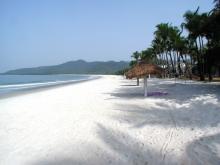By Tanu Jalloh
A survey report released by Ernst & Young (EY) on May 6, 2013 in Johannesburg, South Africa has justified the need for natural resource-rich countries in Africa to go beyond that wealth.
EY is one of the largest professional service firms in the world and one of the ‘big four’ accounting firms, along with Deloitte, KPMG and PricewaterhouseCoopers (PwC).
According to its third Africa Attractiveness Survey, Africa’s share of global foreign direct investment (FDI) has grown over the past five years, highlighting the growing interest from foreign investors.
The report combines an analysis of international investment into Africa over the past five years with a 2013 survey of over 500 global business leaders about their views on the potential of the African market.
“The latest data shows that despite a fall in project numbers from 867 in 2011 to 764 in 2012 — in line with the global trend — project numbers are still significantly higher than anything that preceded the peak of 2008. The continent’s global share of FDI has also grown from 3.2% in 2007 to 5.6% in 2012.
“Due to volatile nature of commodity prices, an over-dependency on a few key sectors clearly raises questions about the sustainability of growth. Despite perceptions to the contrary, less than one third of Africa’s growth has come from natural resources.
“The trend of growing diversification continues, with an ever increasing emphasis on services, manufacturing and infrastructure-related activities. In 2007 extractive industries represented 8% of FDI projects and 26% of capital invested in Africa; in 2012, it was a mere 2% of projects and 12% of capital. In comparison, services accounted for 70% of projects in 2012 (up from 45% in 2007), and manufacturing activities accounted for 43% of capital invested in 2012 (up from 22% in 2007).
“Mining and metals is still perceived by survey respondents as the sector with the highest growth potential in Africa, but the number of respondents who believe this (26%) is down from 38% in 2012 and 44% in 2011. In contrast, interest in African infrastructure projects is clearly increasing, with 21% of respondents identifying this as growth sector versus 14% last year and only 4% in 2011.
“Other sectors where there has been a noticeable shift include ICT (14%, up from 8% last year), financial services (13%, up from 6% last year), and education (which has come from virtually nowhere to register 10% this year).”
The situation in Sierra Leone presents a strong argument for the case as proven by the EY findings. Although rich in natural resources, the composition of the country’s Gross Domestic Product (GDP) by sector proves that apart from natural resources agric and industries are a major boost to the economy.
The above explanations were captured in a communication announcing the findings of the survey, thus lending credence to my belief that aside natural resources, countries could lift themselves out of the poverty that keeps ravaging their people.
I have therefore extensively referenced the publication, using six paragraphs from the report to give some context to my argument that countries in Africa could go beyond natural resources to exploiting and exploring other sectors.
Like in Sierra Leone, the idea of natural resources has come to be limited to such wealth as diamond, gold, iron ore, bauxite, oil and gas, etcetera. These together with many such resources comprised the lucrative find in the extractive industries across the continent.
I have always said that other sectors of the economy have come to be neglected, something that bodes well for the unnecessary hype around natural resources and their magic wand to turn around the current state of affairs on the continent.
According to CIA data base, agriculture alone accounts for 43.2% of the country’s GDP. Industry is providing another 37.4% while services cater for 19.3% (2012 est.) Let me take some time to detail my explanation on the above sectors.
Agriculture
The United States Embassy in Freetown puts it even higher. In a 2013 report it says over 50 percent of Sierra Leone’s GDP is related to agriculture, 23 percent to industry, and 26 percent to services. Only about 15 percent of the 5.4 million hectares of farmland is used for agriculture. The Government estimates the 15 percent level will need to rise to 27 percent to supply future domestic consumption demand.
In a profile of the said economic sector by the New Agriculturists, an online publication, Sierra Leone has a diverse environment, ranging from mangrove swamps and rainforests in the west to large plateaus interspersed with mountains in the east. Agriculture – rice, coffee, cocoa, palm kernel, palm oil, peanuts, poultry, cattle, sheep, pigs, fish – is responsible for almost half of Sierra Leone's GDP and employs about two-thirds of the population; yet farming families have the highest levels of poverty, at about 80 per cent. Rice, cassava and vegetables are the main staple crops. According to the Food and Agricultural Organisation, lack of investment, poor access to credit, weak infrastructure and non-existent agricultural support services are the major constraints to agricultural development.
Industries
Industries are the production of an economic good or service within an economy – a sector that covers general mining activities and by extension the extractives industry; small-scale manufacturing that produces beverages, textiles, cigarettes and footwear; petroleum refining and small commercial ship repairs.
The US report, Sierra Leone - Investment Climate Statement 2013, states that “the value of Sierra Leone’s considerable natural resources still has not been successfully leveraged to improve the lives of Sierra Leone citizens. The country is still primarily agrarian with extremely fertile land, promising fishing sector opportunities…”








